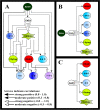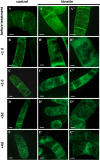Kinetin induces microtubular breakdown, cell cycle arrest and programmed cell death in tobacco BY-2 cells
- PMID: 36239807
- PMCID: PMC10125952
- DOI: 10.1007/s00709-022-01814-6
Kinetin induces microtubular breakdown, cell cycle arrest and programmed cell death in tobacco BY-2 cells
Abstract
Plant cells can undergo regulated cell death in response to exogenous factors (often in a stress context), but also as regular element of development (often regulated by phytohormones). The cellular aspects of these death responses differ, which implies that the early signalling must be different. We use cytokinin-induced programmed cell death as paradigm to get insight into the role of the cytoskeleton for the regulation of developmentally induced cell death, using tobacco BY-2 cells as experimental model. We show that this PCD in response to kinetin correlates with an arrest of the cell cycle, a deregulation of DNA replication, a loss of plasma membrane integrity, a subsequent permeabilisation of the nuclear envelope, an increase of cytosolic calcium correlated with calcium depletion in the culture medium, an increase of callose deposition and the loss of microtubule and actin integrity. We discuss these findings in the context of a working model, where kinetin, mediated by calcium, causes the breakdown of the cytoskeleton, which, either by release of executing proteins or by mitotic catastrophe, will result in PCD.
Keywords: Callose; Cell cycle arrest; Kinetin; Microtubules; Programmed cell death; Tobacco BY-2.
© 2022. The Author(s).
Conflict of interest statement
The authors declare no competing interests.
Figures










Similar articles
-
Membrane-related hallmarks of kinetin-induced PCD of root cortex cells.Plant Cell Rep. 2017 Feb;36(2):343-353. doi: 10.1007/s00299-016-2085-9. Epub 2016 Dec 10. Plant Cell Rep. 2017. PMID: 27942841
-
The crucial elements of the 'last step' of programmed cell death induced by kinetin in root cortex of V. faba ssp. minor seedlings.Plant Cell Rep. 2014 Dec;33(12):2063-76. doi: 10.1007/s00299-014-1681-9. Epub 2014 Sep 12. Plant Cell Rep. 2014. PMID: 25213134
-
Kinetin induces cell death in root cortex cells of Vicia faba ssp. minor seedlings.Protoplasma. 2013 Aug;250(4):851-61. doi: 10.1007/s00709-012-0466-7. Epub 2012 Nov 11. Protoplasma. 2013. PMID: 23143313 Free PMC article.
-
[Biological activity of N6-furfuryladenosine].Postepy Biochem. 2019 Jun 6;65(2):109-117. doi: 10.18388/pb.2019_265. Postepy Biochem. 2019. PMID: 31642649 Review. Polish.
-
Initiation of programmed cell death in self-incompatibility: role for cytoskeleton modifications and several caspase-like activities.Mol Plant. 2008 Nov;1(6):879-87. doi: 10.1093/mp/ssn053. Epub 2008 Oct 17. Mol Plant. 2008. PMID: 19825589 Review.
Cited by
-
Unleash the dogs of death: metacaspase 5, microtubules, and hypersensitive response.Plant Cell Rep. 2025 Jul 30;44(8):184. doi: 10.1007/s00299-025-03567-x. Plant Cell Rep. 2025. PMID: 40736719 Free PMC article.
-
Hormonal crosstalk controls cell death induced by kinetin in roots of Vicia faba ssp. minor seedlings.Sci Rep. 2023 Jul 19;13(1):11661. doi: 10.1038/s41598-023-38641-5. Sci Rep. 2023. PMID: 37468550 Free PMC article.
-
Anti-microtubular activity of total alkaloids and aqueous extract of Detarium microcarpum a medicinal plant harvested in Mali.Protoplasma. 2025 Mar;262(2):415-430. doi: 10.1007/s00709-024-02003-3. Epub 2024 Nov 7. Protoplasma. 2025. PMID: 39505773 Free PMC article.
-
Spearmint targets microtubules by (-)-carvone.Hortic Res. 2024 May 28;11(7):uhae151. doi: 10.1093/hr/uhae151. eCollection 2024 Jul. Hortic Res. 2024. PMID: 38994449 Free PMC article.
-
6-Methyl-5-hepten-2-one promotes programmed cell death during superficial scald development in pear.Mol Hortic. 2024 Aug 27;4(1):32. doi: 10.1186/s43897-024-00107-1. Mol Hortic. 2024. PMID: 39187899 Free PMC article.
References
-
- Allen RF. A cytological study of infection of Baart and Kanred wheats by Puccinia graminis tritici. J Agricult Res. 1923;23:131–152.
-
- Bai M, Liang MJ, Huai B, Gao H, Tong PP, Shen RX, He HJ, Wu H. Ca2+-dependent nuclease is involved in DNA degradation during the formation of the secretory cavity by programmed cell death in fruit of Citrus grandis ‘Tomentosa’. J Exp Bot. 2020;71:4812–4827. doi: 10.1093/jxb/eraa199. - DOI - PMC - PubMed
MeSH terms
Substances
Grants and funding
LinkOut - more resources
Full Text Sources

